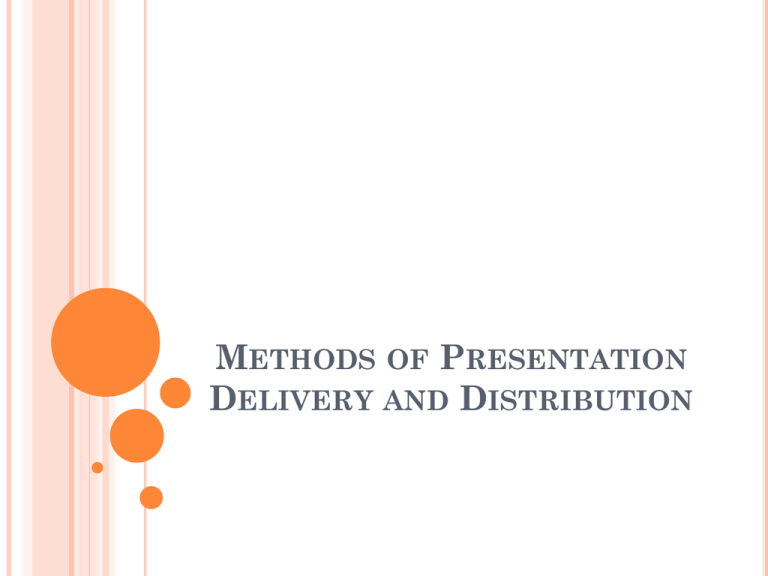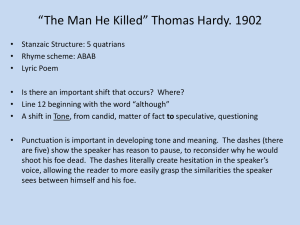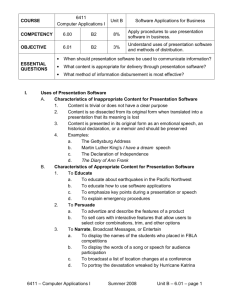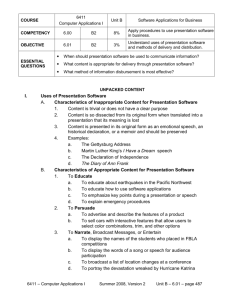Methods of Presentation Delivery
advertisement

METHODS OF PRESENTATION DELIVERY AND DISTRIBUTION When presenting a PowerPoint presentation, the Method of Delivery and Distribution are used separately or are used in combination— depending upon the Message and the Target Audience. 2 SIX METHODS OF PRESENTATION DELIVERY AND DISTRIBUTION 1. Group Delivery with Speaker 2. Group Delivery without Speaker 3. Continuous Loop 4. Rolling Script 5. Self-Serve 6. As a hard copy GROUP DELIVERY WITH SPEAKER 4 GROUP DELIVERY WITH SPEAKER Group Delivery with Speaker is used as a supplement and complement to a speaker-delivered presentation. 1. Slides support information presented by the speaker. 2. Slides display graphics that enhance communication. 3. Slides present key points for added 5 emphasis of content. GROUP DELIVERY WITH SPEAKER 4. The key word in this method is supplement! When delivered with an oral presentation, the slide show content should not contain so much information that it can substitute for the speaker! 6 GROUP DELIVERY WITHOUT SPEAKER 7 GROUP DELIVERY WITHOUT SPEAKER 1. 2. 3. 4. Presentation is played one time to an audience. Does not require explanation or interpretation by a speaker. May be displayed to entertain an audience prior to a speech or event. May be used to inform audience about procedures. 8 CONTINUOUS LOOP 9 CONTINUOUS LOOP 1. 2. 3. 4. Presentation is played repeatedly (on-loop) until manually stopped. Presentation may or may not have a logical beginning and ending. Often used in trade shows where people rotate through at different times throughout the day May be used to broadcast general information, such as school announcements, schedule changes, or changes to room 10 locations, etc. ROLLING SCRIPT 11 ROLLING SCRIPT 1. 2. Presentation is played at moderate pace to allow for user participation. Presentation is usually stand-alone content, such as a prop for posting the lyrics of a song at a concert or the lines of a poem. 12 SELF-SERVE 1. 2. 3. May be delivered via a website, such as Microsoft training presentations that are userselected and interactive. Self-paced and often interactive May be accompanied by a narration embedded within the presentation. 13 AS A HARD COPY A Hard Copy is used to complement presentations and enable retention of information. A Hard Copy is used. . . . . 1. To enable comprehension 2. To assist the speaker Example: Print out a copy of the PowerPoint slides and give to audience members to help them understand the presentation by reading along as it is presented via a 14 screen. A HARD COPY 1. To enable audience comprehension: a) This method is especially effective when the content: 1. is foreign (new) to the audience or user 2. has to be remembered 3. is procedural (1, 2, 3, 4) 4. or is presented to a large group 15 A HARD COPY b) A handout with 3 slides per page allows room for users to record notes beside each slide. c) The # of slides per sheet should vary according to the amount of text on each slide and the space needed for taking notes. d) There’s little point in distributing handouts that are too small to read. 16 A HARD COPY e) Handouts can be distributed in color, grayscale, or black and white. If printing on a black and white printer, be sure to select black and white or grayscale format to ensure clear prints. f) Include a footer. The footer should be formatted on all handouts that are to be distributed. 17 A HARD COPY 2. To assist the speaker: a. A Notes Page contains one slide per page and any notes that accompany the slide. b. An Outline View presents the information in compact form without graphics. c. The Speaker has the notes or outline in front of her/him while the presentation is displayed in the background. 18









